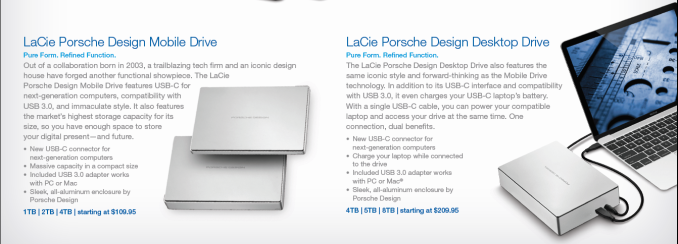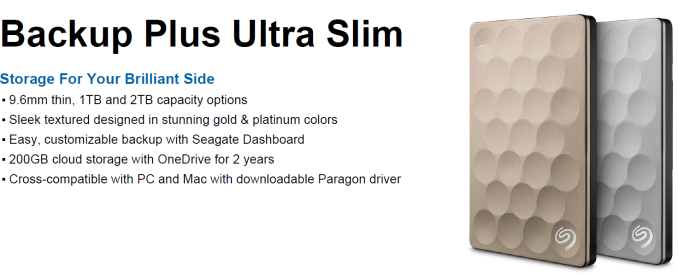Seagate Updates DAS Portfolio at CES 2016
by Ganesh T S on January 5, 2016 11:35 AM EST
Seagate has announced four new DAS (direct attached storage) products at CES 2016. Three of them target the premium / luxury market under the LaCie brand name.
- Seagate Backup Plus Ultra Slim USB 3.0 bus-powered external hard drive
- LaCie Porsche Design USB 3.0 Type-C bus-powered external hard drive (mobile model)
- LaCie Porsche Design USB 3.0 Type-C external hard drive (desktop model) with power delivery
- LaCie Chrome USB 3.1 Type-C external SSD
The LaCie Chrome USB 3.1 Type-C external SSD is easily the most impressive announcement of the four.
Obviously, one of the key points of the LaCie products is the striking industrial design, and the Chrome is no exception.
The product contains two 512GB M.2 SATA SSDs in RAID-0 (effective user capacity is 1TB). It can support data rates of up to 940 MBps, thanks to the integrated ASMedia ASM1352R dual SATA to USB 3.1 Gen 2 bridge chip.
Seagate touts the aluminium enclosure, efficient triple cooling system, magnetized cable management (it is similar to the 2big Thunderbolt 2 product in this respect) and a removable magnetized display stand as unique features for this product.
It must be noted that the Chrome does need an external power connector (understandable due to the need to power two M.2 SSDs). The above gallery shows us the various external aspects of the Chrome unit.
The unit will retail for $1100 and be available later this quarter.
The LaCie Porsche Design USB 3.0 Type-C external hard drives have a new industrial design for the aluminium enclosure and come with a Type-C connector. Other than that, there is nothing too striking about them. The desktop model needs external power, but, it also does power delivery over its Type-C port (making it ideal for devices like the MacBook). Both the Mobile and Desktop versions come with an USB Type-A to USB Type-C cable also (in addition to the Type-C to Type-C cable). This enables compatibility with a wider variety of systems.
The Mobile version comes in 1TB, 2TB and 4TB capacities, starting at $110. The Desktop Drive comes in 4TB, 5TB and 8TB capacities, starting at $210.
Rounding up the product launches is the Seagate Backup Plus Ultra Slim. It is a 2.5" hard drive, and the firmware features are similar to the Seagate Backup Plus we reviewed last August. This implies the integration of a Seagate Dashboard for providing more features compared to a standard external hard drive. The device also comes with 200GB of OneDrive cloud storage valid for two years. It is also compatible with the Lyve photo management software.
The technically interesting aspects include the 9.6mm thickness (Seagate indicated that it is the thinnest external hard drive in its capacity class in the market right now). It comes in 1TB and 2TB capacities with a two-platter design. Cross-platform compatibility is enabled by a free Paragon driver download (enabling Macs to read drives formatted in NTFS and Windows PCs to read drives formatted in HFS+).
The Seagate Backup Plus Ultra Slim comes in 1TB and 2TB capacities. We don't have pricing details yet, but, availability is slated for later this quarter.



















12 Comments
View All Comments
adityarjun - Tuesday, January 5, 2016 - link
Is it possible for desktop drives, even if not these ones in particular, to be powered by USB Type C ports as well as to transfer data through the same port at the same time?bill.rookard - Tuesday, January 5, 2016 - link
USB type C ports are supposedly capable of providing up to 100w power transfer. So - since most full size desktop drives require about 1.5a during normal operation, but up to 3-4 amps during spinup. So - 50w on startup, well within the 100w max.rtho782 - Tuesday, January 5, 2016 - link
But the startup inrush current is for a very short duration, could you not resolve this with an ultracap, charge it over say 3 seconds, then spin up, never drawing more than about 10W.name99 - Tuesday, January 5, 2016 - link
Wouldn't it be more correct to say that "USB type C ports can NEGOTIATE up to 100W power"?As far as I can tell from looking around, all that is guaranteed available is the same 4.5W (900mA at 5V) that USB-3 promises. Beyond that you have to negotiate and many devices (eg your smartphone) are presumably not going to give you anything more.
Also 100W seems high. The highest I can see is the ability to supply 3A over 5V, which would give 15W.
USB Power delivery promises 100W, but that's yet another spec that isn't (as far as I know) an essential part of the USB-C spec, and which I imagine will rarely be supported by non-power bricks. Even something like an iMac can hardly commit to supporting 100W on each of 4 USB ports; it just doesn't come with a 400W (plus enough to run the iMac) power supply.
ganeshts - Tuesday, January 5, 2016 - link
USB Type-C can support UP TO 100W for power delivery. I was given to understand that the Porsche Design Desktop introduced at CES can do up to 15W only.Dahak - Wednesday, January 6, 2016 - link
As others have stated, while USB Type C ports can support UP TO 100W for power delivery, there is no way of knowing if the port is designed for that.It is not a required part of the spec as you have to design additional power delivery components to the port
Dahak - Wednesday, January 6, 2016 - link
Really need an edit button..I should clarify, the port on the motherboard/laptop has to be designed to provide the extra power over and above the minimum required for the spec
bill44 - Tuesday, January 5, 2016 - link
When can we expect Thunderbolt 3 external SSDs? PCIe Gen 3x4 Samsung M.2 950 Pro 1TB in an external case with Thunderbolt 3 Type-C port that can do >2Gbps.The current bridge chips (M.2 to USB3.1 Gen 2) only uses the B-key for SATAIII mode, not the full PCIe Gen 3 x4 bandwidth (M-key).
There would be no need for 2x mSATA in RAID0 or 2x M.2 in RAID0 to saturate the USB3.1 Gen 2 10Gbps bus, 1x M.2 M-Key 2x lane mode should be able to do that.
Since Thunderbolt 3 (40Gbps) uses PCIe natively, it would be the best choice for external M.2 storage. USB3.1 Gen 2 could be the backup option on such a drive (albeit slower), as both uses Type-C connector. Current solutions use 1x thunderbolt + 1x USB3.0, new ones only need 1x Type-C.
Where are the bridge chips?
m2inor - Tuesday, January 5, 2016 - link
Computers with Type-C USB 3 or 3.1 only guarantees 4.5 watts, and this is the USB 900ma @5V spec.Computers with Type-C Thunderbolt 3 implementations guarantee 15W to either USB 3.1 or Thunderbolt connected devices.
Looks like the Porsche Desktop drives likely only guarantee limited power to a connected computer. Goal probably was to be able to connect to Apple's Macbook or the new Alpine Ridge/Skylake Windows laptops for charging while drive adds disk storage at the same time.
Perhaps what needs clarification is how much power the PD pass thru provides.
Note well, the PD power spec is 5v@3A for 15W, and 20v@3A for 60W. To get to 100W with the PD spec requires hipower Type-C cable that handles 20v@5A.
Dig into the USB 3.1 PD spec to understand why, and why it's going to be messy for awhile as the industry and end-ysers adapt.
Also, don't forget that those Type-C passive cables have current AND RF requirements to handle USB3.1 and Thunderbolt 3 reliably at 10Gbps and 20Gbps respectively.
m2inor - Tuesday, January 5, 2016 - link
According to info on LaCie website:"Delivers up to 30W of power to charge compatible laptops such as the Apple® MacBook®."